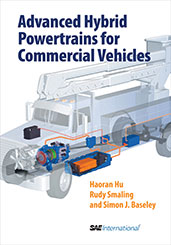2019-04-02
Electrified Drive-Unit Parametric Mechanical-Loss Model Development and Calibration 2019-01-1298
As the automotive industry vies to meet progressively more stringent global CO2 regulations in a cost-effective manner, electrified drive system cost and losses must be reduced. To this end, a parametric Drive Unit (DU) mechanical-loss model was developed to aid in the design and development of electrified propulsion systems, where the total propulsion system cost and DU losses can be directly linked (e.g., Hybrid Electric Vehicle (HEV) motor/inverter/engine content, or Battery Electric Vehicle (BEV) battery size).
Many DUs for electrified propulsion systems are relatively “simple” drive systems, consisting of gears, bearings, shafts, lip seals, and an electric motor(s), but without clutches, high-pressure lube systems, or chains/belts as found in conventional automatic transmissions. The DU loss model described in this paper studies these simple DUs, with the mechanical losses dissected into 10 loss components.
Analysis was conducted at the vehicle level to assess the relative loss contributions of the DU, motors, engine, etc. for the entire vehicle propulsion system to show the DU loss contribution to the total system. The DU loss model was used to deconstruct the total DU mechanical loss into subcomponents of Speed-Dependent (SD) and Load-Dependent (LD) losses. For each loss component, standard loss model equations were modified, or new equations were created, and calibrated based on loss data/trends of component-level bench tests, supplier data, and/or DU-level tests. Particular emphasis was placed on the LD components of the gear and bearing losses, as a function of load, speed and temperature, as they can represent a large portion of the total DU loss. DU-level tests were conducted at various positive and negative (regenerative braking) loads, speeds, fluid types, temperatures, and sump-fill levels to aid the development of the model. The model calibration methodology is described, where the calibrations of some of the individual component models were iterated, so that a universal set of loss model calibrations produced loss results that closely matched the test DU losses at the various operating conditions.
SAE MOBILUS
Subscribers can view annotate, and download all of SAE's content. Learn More »

BOOK
Advanced Hybrid Powertrains for Commercial Vehicles
TECHNICAL PAPER
Thermal Modeling of DC/AC Inverter for Electrified Powertrain Systems
2020-01-1384
TECHNICAL PAPER
Analytical Study on Electric Motor Whine Radiated from Hybrid Vehicle Transmission
2017-01-1055
